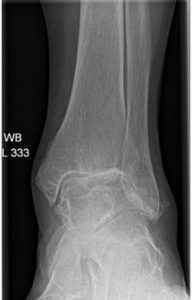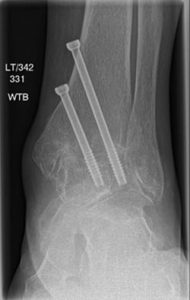 What will the surgery involve?
What will the surgery involve?
i. Anaesthetic – usually a general anaesthetic is required; as well as this, local anaesthetic will usually be placed around the nerves that provide the sensation to your ankle and foot (popliteal nerve block). This will mean that the foot/ ankle is likely to be numb when you wake after the surgery- this usually lasts between 12 and 24 hours. You will have a chance to discuss your anaesthetic with the anaesthetist before the operation.
ii. Incisions – two small incisions on the front of the ankle:
one on the inside
one on the outside
two small incisions a little above the ankle on the inside
iii. The surgery – Your ankle will be inspected through the ’arthroscope’ (telescope) and any residual cartilage is removed, the bone under the cartilage is stimulated to form new bone and the ankle is stabilised using screws.
iv. Stitches – Removable, non-dissolving sutures will be used to close the skin. These will be removed at your appointment about two weeks after surgery.
v. Dressings – Special dressings will be placed on the ankle and a plaster back slab will be applied, these should all be left in place until you are reviewed in the clinic at two weeks following the operation.
The plaster should be kept dry, applying a waterproof cover when showering is useful, the most commonly used can be found at www.limboproducts.co.uk
 What happens after the surgery?
What happens after the surgery?
i. Going home – This will either be the same day or the following morning depending on the time of surgery and home situation.
ii. Pain relief – The local anaesthetic ankle should provide some pain relief, but you will be supplied with pain relieving tablets by the hospital (usually co-codamol and tramadol) these should be taken regularly initially. You can gradually reduce these as your pain allows (tramadol is the stronger pain killer). You should avoid non steroidal anti-inflammatories (eg. nurofen) as these might reduce the chance of the bones fusing.
You will find it more comfortable to keep your foot elevated, if possible above the level of your heart, as much as you can for the first two weeks after surgery. This will help reduce the swelling and therefore also help wound healing.
iii. Walking – The amount of weight you will be able to apply through the foot/ ankle is as follows:
Weeks 0-2 No weight
Weeks 2-4 Partial weight bearing in plaster
Weeks 4-8 Full weight bearing in plaster
Weeks 8-12 Full weight bearing in removable boot.
v. Driving – If you the surgery is on your left ankle and you have an automatic car you may be able to drive after your two week review, but you should check with your insurance company first.
If the surgery is on your right ankle you will not be able to drive until you can walk without crutches confidently. At this point you should check that you can place your foot on the pedal with sufficient force to do an emergency stop without pain, this should be tried in a stationary car; if you are able to do this you should then contact your insurance company to ensure that they will provide cover for you.
vi. Follow up – You will be reviewed in the outpatient clinic at:
2 weeks after surgery when the sutures will be removed and the ’back slab’ plaster changed for a full plaster.
8 weeks after surgery when the plaster will be removed and an X Ray taken, if this is satisfactory the plaster will be changed for a pneumatic walking boot.
12 weeks after surgery and another X Ray taken, if this is satisfactory then the boot will be removed.
6 months after surgery and further follow up will then depend on your progress.
vii. Return to work – Approximately:
Office job – 4 -6 weeks
Mobile job requiring driving – 14 weeks
Manual labour – 18 weeks
What are the risks of the operation?
There are a small number of risks of surgery including infection, nerve damage, blood clots, ongoing pain and the need for further surgery (please see General Risks of Foot and Ankle Surgery for further information)
